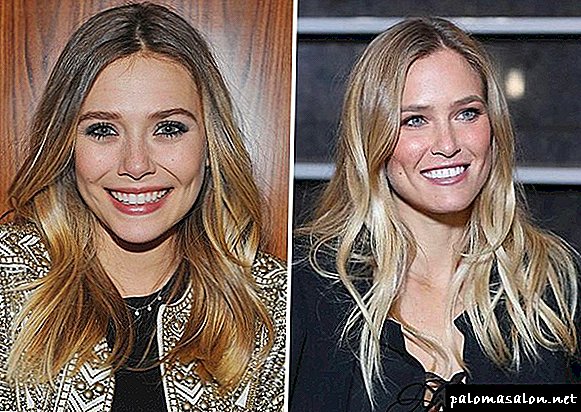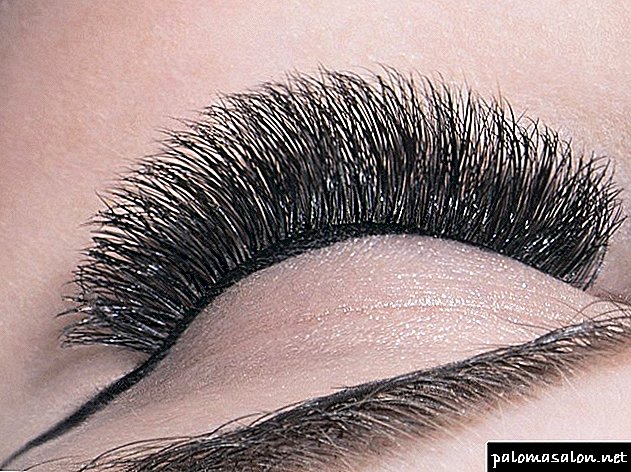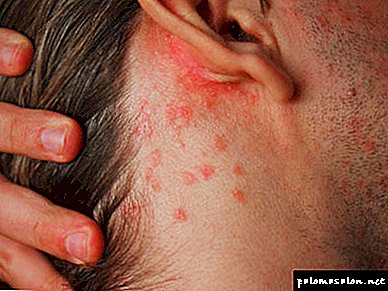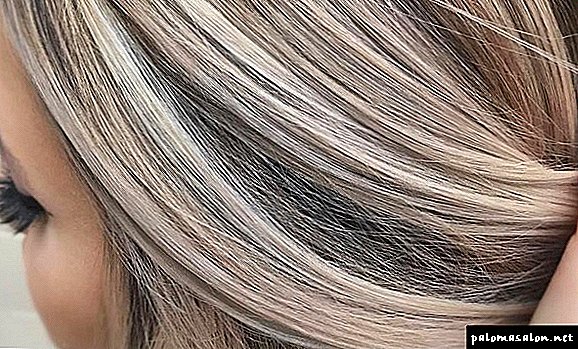

Do you dream of a cardinal change of image, but are you afraid to get an ugly result? Today we will tell you how hair dyeing goes from dark to light, as well as give some important tips with which you can easily cope with the task.
Method 1. Lightening
If you decide to say goodbye to the dark strands forever, try a gradual lightening procedure, the essence of which is to apply a special brightener to your hair in stages (allowing it to be brightened by 11 tones). This method is very tough, so it does not suit the owners of thin and damaged hair. Yes, and the rest of the girls is also better to choose the most soft composition - it retains the structure and natural shine of the hair.
The procedure of gradual clarification takes a lot of time - from one to several months.
It is impossible to speed up the process! The fact is that the improper use of lightening agents can greatly harm the condition of the hair and turn them into straw with split ends.
To protect yourself from such troubles, select the brightener based on the type of strands, their structure and shade.
It should also be noted that there are compositions available with the help of which you can radically change the image in just 2 sessions. However, such means are incredibly aggressive - they will dry out a lot and literally burn the strands. This option can only be used to brighten the tips (for example, for the ombr). In extreme cases, they can always be cut off.
Method 2. Highlighting
To repaint the strands of dark to light color, you can make highlights. This is an ideal way to brighten hair - it passes gradually, does not harm the structure of the strands, and therefore can safely be called safe. After completing 2-3 sessions, you can apply any of the shades of the blond.
Highlighting can be done both in a professional salon and at home - another important plus. To do this, you will need paint of the desired color, a clarifier, a brush, a foil or a special cap with holes, a container for mixing the composition and a cape.
If you wish, you can use the ready set for highlighting (they are often found in the L'Oreal line). And now the main secret - during each subsequent procedure, try to capture as many dark locks as possible.
This will gradually lighten the entire head of hair, and then toned it into the desired shade.
Method 3. Coloring
Lightening dark hair can be done with a special dye. Such reincarnation should also be carried out in stages, using a lighter shade each time. To become a blonde, enough to spend about 5 sessions. You can do this procedure not only in the cabin, but also with your own hands. For painting suitable as resistant ammonia paints, and gentle mousses.
Method 4. Washing or decoupling
Another popular way to go from a dark shade to a light shade is decapitation - a special procedure during which an artificial dye is washed out of the hair. True, voids are formed in its places, so the hair looks thin and weak. Correct these nuances can correct care with the help of restorative and nourishing cosmetics.
The wash is very effective, since in one session you can lighten up to 3-4 shades at once. Then strands can be painted with any blond paint - the paint will lie evenly and give a very stylish tone.
Is it possible to apply the wash yourself? Sure you may. You can use both industrial and home remedies - beer, vegetable oil, kefir, chamomile or laundry soap. They can be used as masks and rinses. Here are just a few recipes.
Tips on how to decapitate dark hair:
Recipe number 1. Chamomile
- Pour 200 ml of boiling water over 150 grams of dried chamomile flowers.
- Insist on a lid for 2 hours.
- Filter.
- Add 60 grams of glycerin.
- Saturate the hair with this composition.
- Build a warming cap.
- Wait 2-3 hours and rinse with warm running water.
- Mix 1 liter of fat kefir with 1 tbsp. l vegetable oil (olive, sunflower or burdock).
- Pour 1 tbsp. l salt.
- Mix well and apply to the strands.
- Build a warming cap.
- Wait about an hour.
- Wash your hair with shampoo.
- Repeat no more than 2 times a day for several months.
- Mix 10 tbsp. l soda with 1 cup of warm water.
- Mix well.
- Add 1 tsp. salt.
- Lubricate the hair with this gruel.
- Wait at least an hour.
- Rinse with running water.
Recipe number 4. Lemon juice
- Connect 2 eggs with 100 ml of fatty kefir.
- Add 2 tbsp. l lemon juice, 1 tsp. shampoo and 4 tbsp. l vodka.
- Mix well.
- Apply the composition over the entire length.
- Build a warming cap.
- Leave overnight, and in the morning, rinse with running water and shampoo.
- Repeat every day for a week.
- Mix 40 gr. pink clay with 200 ml of kefir. If the hair is dry, replace the clay with the same amount of yeast.
- Apply for 20 minutes.
- Wash off with water and shampoo.
- Repeat every day for a week.
Method 6. Interesting painting
Owners of dark on the nature of the hair incredibly lucky - you can easily make a very fashionable painting, in which the roots are dark and hair is blond.
It is called an ombra or a regrown blond. This technique has many advantages, but the main thing is that it does not affect the roots and does not require regular visits to the salon.
In addition, with its help, you risk becoming the most fashionable and beautiful.
Some more tips
For those who decide to turn from a brunette to a blonde, we advise you to take note of some important tips.
Tip 1. Do not rush to the result - it is a huge stress to the health of hair. The optimal number of procedures for painting in a light tone - no more than 5 sessions.
Tip 2. Spend staining, washing or bleaching only good masters.
Tip 3. Coloring hair should be carried out with quality tools from proven manufacturers. When buying, which is better to make in specialized stores, do not forget to check the expiration date. But cheap brands should be completely excluded. Believe me, after using them you will spend a lot more money on restoring the hair structure.
Tip 4. Pay attention to the composition of your chosen dye. It is desirable that it included extracts of medicinal plants, natural oils, UV filters and other useful components. Also important is the percentage of oxidant contained in the paint - the higher it is, the more likely it is that you will get the desired shade.
Tip 5. Before dyeing dark hair with a light-colored paint, a bleaching procedure should be carried out. Otherwise, the paint either will not be taken, or will fall ugly stains.
Powder, oil or cream formulations are used for clarification. The last two contain special substances that several times increase the effect of the oxidizing agent.
But when using powder means there is a big risk to burn the scalp.
Tip 6. Before using any cosmetic products should be tested for the presence of an allergic reaction. To do this, apply a small amount of the finished composition on the skin of the wrist or elbow, wait 15 minutes and check the result. If during this time there is a burning sensation, irritation or redness, discard this tool.
Tip 7. Repaint the hair in light colors, be sure to buy shampoo, mask and balm for blonde hair. They contain special ingredients that protect the color from burning and leaching.
Tip 8. Do not forget to regularly paint the growing roots (if the technology does not provide the opposite effect).
Tip 9. To maintain the purity and brightness of the shade, periodically tint the strands with a silver or purple tonic.
Tip 10. When choosing a paint color, remember that it should be combined with your natural color type. The contrast between the hair and the shade of the eyes and skin looks just awful!
Modern methods of hair coloring
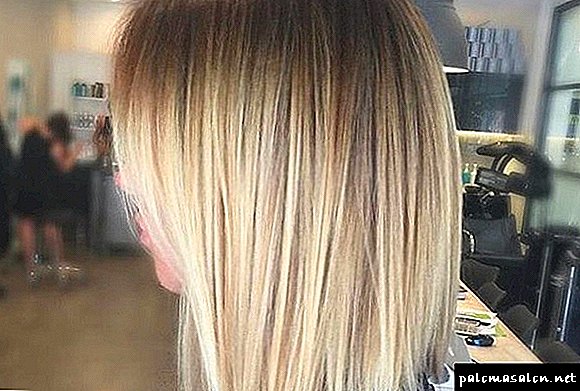
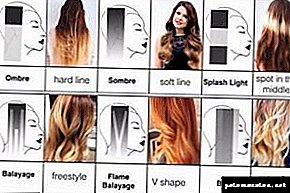
Millions of women around the world use coloring in order to be bright, individual and unique. Many still go to beauty salons to perform hair coloring, however, this procedure is becoming more and more popular at home every day.
Basic hair coloring methods
The main categories of methods for changing hair color include:
- Classic coloringwhich consists in uniform putting paint, without resorting to special professional receptions. As a result, the hair gets a uniform shade.
- Highlighting allows you to give individual locks lighter shades compared to the main color.
This method is perfect for lovers of creativity, as the color of the tips of the hair can be completely different from the main hair color. Lightening hair is suitable for those who had a dark shade.
To do this, apply special solutions before staining, and only after that your master can achieve the desired uniform blond. 3D or 3D coloring Hair gives hair a special volume and originality.
For this type of coloring, special holographic means are used and therefore it is best to find the master in advance and make sure that he is able to do this.
From brunette to blonde
Transition from dark color hair in light turns a stinging brunette into a charming blonde. This is a very complicated procedure. It takes a lot of time and requires great skill from the master. In order to get the light color of the curls, hairdressers resort to one of the following methods of coloring:
- An acidic wash, though not entirely benign, is an option for a gradual transition from dark to light hair. To do this, it is applied to the hair a little bleaching them. After two weeks, the procedure is repeated with the addition of paint two shades lighter than the desired result.
- Natural hair pigmentation can be burned out using peroxide. And so that the hair became light and looked natural and neat, they are painted after lightening in any shade. This is the most effective method, but not very healthy hair. After such procedures strands become dull and fragile.
- At home, the desired result can be achieved using pure henna. In order to get the desired light shade, add an infusion of chamomile flowers and hold it for 40 minutes. This procedure can be performed every week without harm to the hair.
Monochromatic painting
Single tone staining will not only add shine and smoothness to hair, but will add a zest to the image, drastically changing it. This method is best to paint the hair from root to tip, using a paint of the same color.
It is important to remember that a similar procedure should be carried out only on healthy hair. Beauty, although it requires sacrifice, is not worth loosening your curls for the sake of it.
In addition, it is not recommended to color the hair after a perm in order to avoid the appearance of colored spots.
Professionals recommend changing hair color to two to three tones. So they will always look healthy.
Highlighting is a way to drastically change your appearance.
For many women hair highlights became a permanent procedure. In this way, you can disguise gray hair or add brightness and charm to your look. This will be ideal for those who do not want to completely dye their hair.
It is best to enroll to the master and entrust such a difficult process to him.
There are the following ways of highlighting:
- using a hat with a lot of holes, through which thin strands are pulled out in a staggered manner with a special hook and painted in lighter tones,
- applying American highlighting, which allows you to give hair a lively and natural shine, thanks to the use of about three different tones,
- Crazy Colors is the highlighting of rich shades with contrasting colors to create creative and unusual hairstyles.
Despite the fact that highlighting is a rather complicated process, the reflection in the mirror will say that the forces were not wasted!
Every week a new image
Hair tinting - it is painting not by permanent paints, but by tinting means. So you can try different colors and decide on the future full color. With this method, the relevance and beauty of hairstyles will always keep up with fashion trends.
Toning allows you to use when coloring several colors.
The advantages of this method include:
- the possibility of staining after perm,
- the instability of the dye allows you to change the image every 6 - 8 weeks,
- no ammonia and hydrogen peroxide,
- allergic testing is not required
- Coloring agents are easy to use.
Shatush - naturalness first of all
Many girls strive to achieve naturalness and naturalness when dyeing hair. Coloring shatush creates it. This method allows you to simulate the effect of natural hair burning, creates a relief from darker roots to brighter tips. Shatush adds depth to color, and hair volume. This technique perfectly hides regrown roots and masks light gray hair.
Shatush is performed on small, frequent, chaotically arranged locks, but not along the entire length and with a small indentation. Borders of coloring are hidden due to a pile of strands.
Royal beauty with 3D hair coloring
3D coloring - this is not only a tribute to fashion, it is also an opportunity to look truly like a king. The advantages of this type of hair coloring is considered to be the richness of the color palette, the natural look of the hairstyle and the resulting volume effect.
3D technique It is based on the combination of colors of one scale applied in a certain way on the hair. And the resulting play and smooth transitions between shades allow you to reveal the versatility of the palette and the true volume.
The procedure itself is gentle and does not require prior lightening of the hair, as the master of beauty selects shades to match the natural color. Initially, the main tone is chosen, which is complemented by 3-4 shades.
Coloring the roots - from the need to creativity
After dyeing the hair, after a few weeks, regrown roots are noticeable, which often does not look very neat. Therefore, so that the hair always pleases the eye, you need to regularly tint the hair along the entire length.
If the hair has one tone, then in this case, when painting the roots, it is necessary to apply funds directly on them, and after a certain time stretch the paint over the entire length of the hair.
If the curls are dyed using different techniques and mixing colors, then this procedure is best left to a professional.
The roots are also stained, following the fashion. To do this, use bright saturated colors that are applied to the root zone.Thus, the hairstyle turns out original and creative.
Coloring as a way of expression
There are two types coloring:
- full - at which the whole mass of hair is processed with the replacement of the natural shade,
- partial - in which part of the hair is colored and the natural tone is decisive,
- longitudinal - in which different shades fall over the entire length of the hair,
- transverse - in which the strand is divided into several zones, which are painted in different colors.
The advantages of this method include:
- visual hair opulence
- giving spectacularity to any haircut and underlining its structure,
- the ability to change the color of your hair, combing colored strands in different ways.
Some masters working with coloring technique may also offer an unusual way of applying this technique - screen painting. The result is a creative design or, for example, tiger hair color.
Are you ready to change your life? If the answer is "Yes", then you came to the address. The masters presented on our website will perform for you all the types of staining described above.
Hair coloring: color matching and 6 fashionable techniques
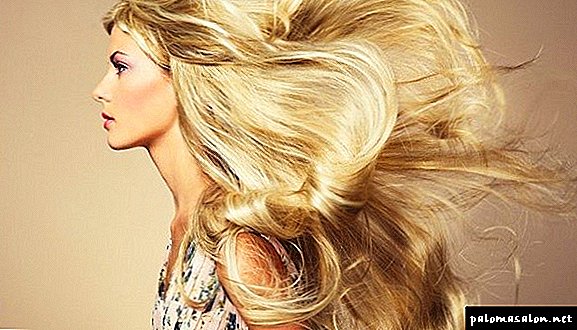
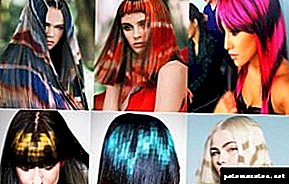
Author Helena date Nov 17, 2017
Women began to dye their hair in ancient times.
Greek women used lemon juice for brightening, Egyptian women painted black with Basma, English women used henna.
Fortunately, now fashionable women do not need to water their heads with sour milk or sprinkle with ashes. A huge number of colors allows you to give your hair almost any color.
How to choose paint
Hair coloring allows you to change the color of natural hair. In order to accurately choose the right paint, you need to decide what exactly you want to do - completely change the color, refresh the old color, tint individual strands, disguise gray hair.
Funds can be divided into three types:
- The first level is tinting.
- The second level is semi-resistant.
- The third level is persistent.
Coloring agents are designed to change shade. This composition does not contain harmful components, hydrogen peroxide and ammonia. The coloring pigment does not penetrate deep into the hair structure, but only cover it with the thinnest film.
Such funds do not cause harm, but they are washed off rather quickly, in 2-3 weeks. These are various tinted shampoos, balms, skins. They have an obvious advantage - you can not just refresh and brighten your own hair color, but also experiment with boldness without fear of long-term effects.
Semi-resistant paints contain a little hydrogen peroxide in their composition and can make curls lighter or darker by one tone. Hair coloring in this case will be quite stable, the result will last up to two months.
Means of this type are gentle and suitable for frizzy, weak and dry hair.
Resistant paints contain up to 12% hydrogen peroxide. They are able to drastically change the color of hair and paint over gray hair. The pigment penetrates into the very depths, under the scales of hair and lasts a long time.
We select the color
How to choose a color for coloring? It is necessary to approach the choice of means responsibly, especially if it is decided to apply resistant paint. It is necessary to take into account the natural shade of hair, skin and eyes.
If the girl is often filled with paint, then it is recommended to avoid reddish shades. But light-skinned beauties warm tone on the contrary give a blush.
Brown-eyed and green-eyed fit warm shades - gold, red, red. Blue-eyed and gray-eyed girls should choose beige and cold tones. For the selection of paint you need to know your color type.
Spring color type
Spring girls have light-colored eyes - green, blue, amber. The skin is pale, but warm. Hair - from light to dark. A bright example of spring is Nicole Kidman.
The girl-spring suit light colors, honey tones, chocolate and copper colors. Light red, blond platinum and ash that will make beauty too cold will not look. When choosing chocolate and light brown tones, you can make individual locks golden.
Summer color type
The summer girl conquers with her fair cold skin, the purity of blue or gray eyes. Hair - from light to dark. An example of a summer color type is Maria Sharapova. Fly fit cool shades. Platinum, ashy, light brown colors look amazing.
Dark tones fly better avoided. Reddish shades are not suitable for naturally rosy girls, and golden for pale ones with yellowish skin.
Autumn color type
Autumn beauties have dark hair, and eyes can be both dark and light - brown, green, blue. The skin is golden. A vivid example is Jessica Alba. Girls with such appearance will shine with a rich, intense shade - chocolate, chestnut, cinnamon. Brighter copper, light brown, gold will also suit.
Winter color type
The eyes of winter can be both light and dark, but with a cold tinge - gray, blue, brown, black. The skin is cold tones, but can be both olive and light.
Winter girl - a sort of Snow White, woven of contrasts - white skin, scarlet lips, hair the color of ebony. A prime example is Dita Von Teese. Winter beauties recommended ashen dark brown, black. Warm shades and blond should be avoided.
Types of staining
There are lots of different ways of staining. An experienced master can name more than 100 technician. In the 2015-2016 season the most popular:
- Monochromatic painting, from root to tip in one color. The classic version does not go out of fashion, and naturalness is one of the main trends, so women of fashion choose black, chestnut, blond and red.
- Highlighting is giving a part of strands a lighter shade. In this case, each strand is painted separately, and then wrapped in foil. An interesting effect is obtained if we take strands of different thickness.
- Coloring is the application of colors of different shades to the strands. Colors should be harmoniously combined.
- Ombre is a smooth transition from one color to another. In the classic version, this is a transition from dark roots to light-colored tips, but more bold shades can be used.
- Balayazh - lightening strands with a smooth transition from dark roots to bright ends.
- Bronding - a combination of highlighting and coloring, creating the effect of burnt hair and glare.
Care for dyed hair
Regardless of whether you used the services of professionals, or decided to dye your hair yourself, after the procedure they will need careful care. Often, manufacturers of paints produce and care products - shampoos and balsams.
To keep the color longer, try not to use shampoo unnecessarily. Three for after dyeing hair can not be washed. Hot water will damage the curls, also avoid shampoos for greasy hair and anti-dandruff. It is better to purchase special products for the care of dyed hair.
After dyeing it is not recommended to use curling iron or ironing. The enemies for dyed hair are sun, chlorine, care products with natural ingredients. They wash out the pigment. Over time, the color needs to be updated, if necessary, tint the roots. Fully dyeing hair from root to tip can not be more than two times a year.
What if the result did not like
It so happens that the new hair color is not happy. Do not despair, everything can be fixed. Today, the beauty industry offers specialized shampoos and gels that are capable of uncovering hair flakes and washing the pigment out of them.
The process of washing the paint can be done in the cabin. But she is not as safe as we would like, and can harm weakened curls. There are softer, folk ways to get rid of unloved paint - these are kefir and vegetable oil masks, which should be left on all night.
The choice of coloring agents is a complex and responsible process. The result will be affected by the staining technique, the type of paint, and the condition of the curls before the procedure. But even if the staining failed, there is a chance to restore the original color.
All materials are provided for review. Before using recommendations concerning the health of your hair, we recommend that you consult with a specialist. Use of material is permitted only with the active hyperlink to the site.
Shatush - a scattering of sun highlights in the hair
Women love to experiment with the color of their hair. One wants a radical transformation from a blonde to a brunette or vice versa, another one likes a poisonous green bang and orange tips ... Transform, without changing radically, add a head of hair liveliness and volume, refusing from contrasting dyes, let the sunbeams on the hair, without spoiling the strands classic highlighting ... Just for these fashionistas staining and there shatush.
What is "French highlighting"
The term “shatush” itself has only an indirect relation to fashion. This is the name of the finest goat down of the highest grade, from which incredibly soft and light cashmere fabrics are made. Ideally, your hair-style should become the same after dyeing - airy, weightless, but at the same time voluminous, stylish and expensive. This shatush - or French highlighting, as they call this technology - can not look cheap or sloppy, so finding a good master is so important for its execution.
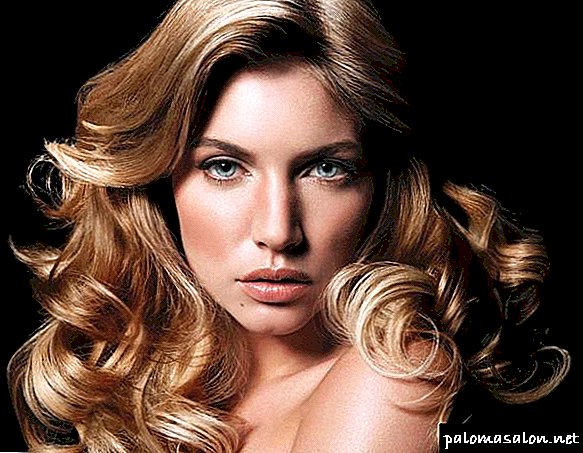 Shatush's main credo is bright and natural.
Shatush's main credo is bright and natural.
The main idea of the tricky novelty is to color the bulk of the hair with bleached and toned locks, selected in a chaotic manner. The uninitiated in the subtleties of the hairdresser's art of the viewer should have the impression that you have just arrived straight from a tropical paradise, where your disobedient whirlwinds have burnt out under the hot sun.
Shatush, ombra and balayazh - what is the difference between methods
The women of fashion who are familiar with the “sunburning” technologies have probably already remembered about similar methods of dyeing - balayaz and ombre. True, they all belong to the same close-knit family, originating from a single “ancestor”, the classic highlighting. All pursue the same goal to add color and volume to locks without sacrificing naturalness. All are performed on similar technologies, mixed, complement each other, so that, looking at the end result, it is not always firmly determined - is it a tie or a shatush? It comes to the fact that some non-professional barbers confidently assert that both the third and third technologies are the same highlighting and do not differ from each other. But it is not so:
- Ombre suggests a uniform "horizontal" coloring of the entire mass of hair. It can have clearly marked or blurred boundaries between color transitions, allows the use of any shades, even the most provocative, fits well on long hair, but with the proper skill of the wizard looks good on short haircuts.
- For hair dyed using the balayazh technique, the presence of contrasting tips and motley strands, completely “scattered” on the head of hair, are characteristic. Natural colors reign here - in addition to bright, sometimes even fiery-red tips, all shades should be in harmony with the natural hair color - carefully blurred borders and slight negligence.
- With a slight stretch of shatush can be called a more gentle and delicate version of balaise. Lightening and then tinting randomly taken strands, the master uses one or two shades, rarely three shades that are close in tone, never stretches the color to the very roots and acts only with the edge of the brush to avoid coarse strokes. To achieve a special smoothness of color transition, the hair is pre-combed, and to give volume, they try to work only with the surface strands, without dyeing them in depth. The most “neat” and light shatush can practically get lost in the mass of hair, leaving a feeling of obscure sun glare, slipping here and there among the curls.
Advantages of the "sun" coloring
The bad thing is that shatush is not as simple as it may seem. To create a masterpiece out of seeming confusion, the master must have a real artistic taste and skill in “sunny” coloring, or your curls risk turning into an indistinct pile of oddly brightened strands that have no appearance or general idea.
To suit: brunettes, blondes or blond?
- Since shatush is primarily a clarification, it looks best on dark hair. Brunettes, brown-haired women, dark-blond young ladies - this is definitely your style! The most popular tones for dark curls today are nutty, chocolate, coffee with milk ... Or those that you like more.
- If you carefully approach the choice of color, you can very well shaded and light-colored head of hair, although the efforts of the master will be not so noticeable on it. Refer to the golden, wheat and honey shades, and with very light hair - to pearl, ashen and bright blond.
- But pure blondes make no sense to paint themselves - all the changes on their blond heads just get lost without a trace.
- The abundance of gray hair also makes senseless use of technology. If deprived of pigment hairs occupy more than a third of the total amount of your hair, mask their partial lightening will not succeed.
- Shatush looks great on long hair, but loses all charm, being used on short haircuts. At a minimum, your curls should reach the shoulder blades, or you can forget about naturalness.
French highlighting as a sparing method of coloring is readily made by the owners of thin, weak hair. Hairstyle will gain airiness and fluffiness without compromising the health of the hair.
Preparing for the painting procedure
Well, without thinking, name the main condition for a successful coloring! The right color? Direct hands from the master? High-quality dye? That's right, and all is secondary. In any case, the primary task is to carry out the procedure in such a way as not to harm the hair. And for this you will need some training.
- A week or two before going to the hairdresser, start making yourself moisturizing and nourishing masks from a mixture of vegetable oils: almond, burdock, castor and any other. If the hair is oily, it will be enough to apply oil on the scalp 2-3 times, stand for half an hour and rinse. With dry and exhausted hair, try repeating the procedure every three days before bedtime, then put a warm cap on your head, cover the pillow with an old towel and leave oil on your hair until the morning. After two weeks, the curls will be ready for coloring.
- Make yourself a haircut beforehand - it will be both pitiful and unwise to cut off the colored strands, as this can bring disharmony into the image created by the master. All kinds of “sun coloring” look great on cascades, ladders, thinning, as well as elongated square and curly curls.
- Choose "your" colors. If you are new to dyeing, it is better to ask for help from a master who will tell you which shades will allow your curls to play for real.
Methods used in salons
Depending on his experience and habits, the master will offer you one of two methods of coloring. The first and most common is as follows:
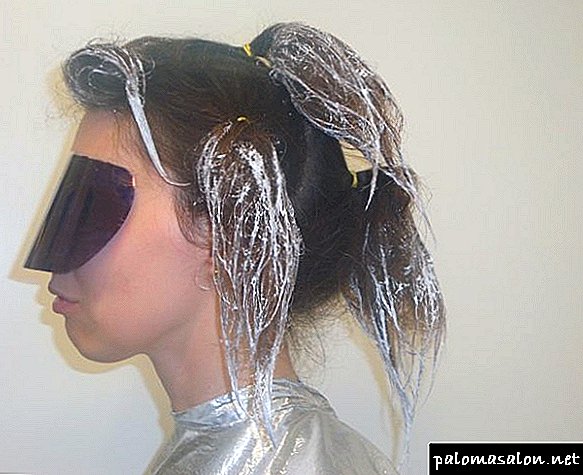 Lightens only the top layer strand
Lightens only the top layer strand
- At first, combed hair will be divided into 2–3 cm wide strands using a comb with a sharp clove and tying them into ponytails.
- Every single strand is well crafted. This is exactly what makes it possible to achieve the most diffuse smooth color transition, for which, in fact, shatush is valued.
- Then the application of a lightening paint will begin, which the master will stretch along the length of the strands with chaotic, not having a certain order and symmetry strokes.They are made by the side of the brush, with short, but not too sharp movements exclusively on the upper layer of hair.
- Processing begins with the lower beams, while the upper ones remain raised and pinned up. As we move to the crown, the strands will be released and superimposed on those already painted. Since neither foil nor film in shatush technology is usually used, the treated hair will come into contact with clean, enhancing the effect of "accidental" burnout.
- The paint will be left to act for 10-40 minutes, depending on the desired degree of clarification, and then carefully washed off.
- In rare cases, this is the case. But to achieve the maximum color depth, it will be better to tint the bleached curls with 2-3 shades close to the natural hair color.
The second method does not require hair, but it is on the shoulder far from every master. You need to own a truly filigree technique of applying paint to achieve the desired effect on smooth hair! However, it may turn out that you will fall into the hands of just such a professional who will lighten and toned your curls without tedious combing.
Ombre staining technique: what is it, what is remarkable and what kinds it is
Ombre hair coloring is a smooth or abrupt transition from one color to another. Synonyms here can be such words and phrases as shatush, blonding, gradient highlighting, degradation.

Beautiful ombra on dark hair of medium length
Such hairstyles look quite impressive: from the roots and up to about the middle of the length, the natural hair color is preserved, then there is a gradual transition to a different shade, and at the ends this tone reaches its maximum intensity.
For information! The transition can be anything from light roots to dark ends, from dark to light, or even from a natural color to a bright fashionable shade (pink, blue, light green, etc.). It can also be done in a soft or sharp form.
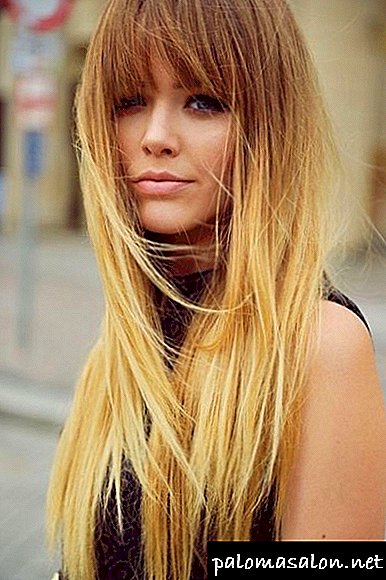
This is how sensual the ombra looks on blond hair
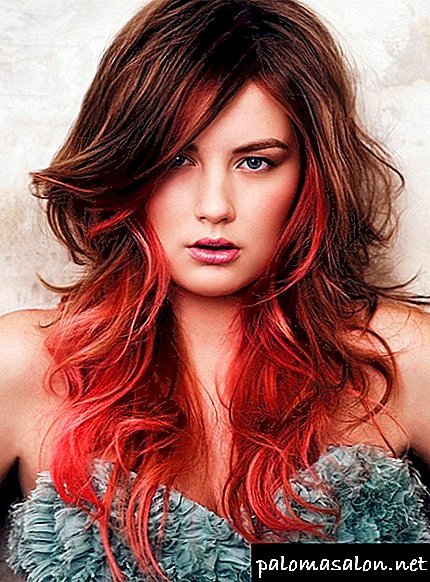
In the photo - an intriguing ombre in red
Coloring at home
Think carefully before you decide to create shatush with your own hands. You have to work without exaggeration on titanic work: to make a good pile, including the back of your head, to “blindly” paint over the strands in the right places, to keep within the measured time, so as not to overdry and not ruin the curls ... But if you decide to, proceed as follows :
- Thoroughly comb strand hair. For convenience, you can fasten them with rubber bands or hairpins, or you can simply throw them forward, on the shoulders, separating by curl just before dyeing. Remember that the final result depends largely on how well the nachit will be made! But to try to make all the strands of the same is not necessary, let them be of different thickness - this will add a natural hair style.
- Dilute the paint.
- Arbitrary strokes apply it to the curls from the back of the head. Do not try to cover the whole head or soak every strand through the dye! The easier, chaotic and free your movements are, the better.
- Wait for the time specified in the instructions.
- Wash your head.
- This and the following items should be performed only by those who have long been familiar with home coloring, for beginners it is better to skip it. Dissolve the selected paint for tinting and “paint” bleached hair, trying to put darker shades closer to the roots, and light - to the tips. Wait again for the paint to set.
- Wash your head.
- Let your hair dry naturally.
Some young ladies use as a brightener ready sets for highlighting, and some tint their hair with natural henna and basma.
Pros and cons of gradient coloring
As part of this style, you can create both classic hairstyles that are perfectly appropriate to wear in schools, offices and other secular institutions, as well as completely informal, suitable for everyone who wants to stand out from the crowd. In addition to this feature, the ombre hair coloring technique has a number of advantages and a couple of minor drawbacks:
- Ombre looks equally beautiful on long / medium curls and short haircuts. The same is with regard to hair color - it does not matter whether they are light or dark, the effect will be interesting anyway.
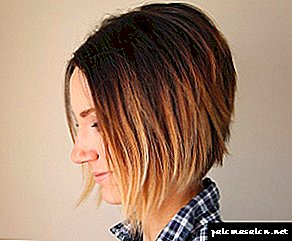
Four-leg + ombre
- In addition, this is an ideal solution for the “adaptation period”, when, after a long painting in any color, you want to finally grow your natural one. No one will catch you in bad taste because of the regrown roots, but on the contrary will consider it a stylish and extraordinary person.
- It is also valuable that taking care of such coloring is much easier and, let's say, harmless to the hair. After all, the need to re-paint will be very rare.
- Moreover, the ombre technique makes it possible to visually correct the shape of the face (lengthen it by lightening the adjacent strands) and make the hair more voluminous (due to the clarification of the ends cut by the cascade).
- To create a gradient in your hair, all the colors of the rainbow are suitable!
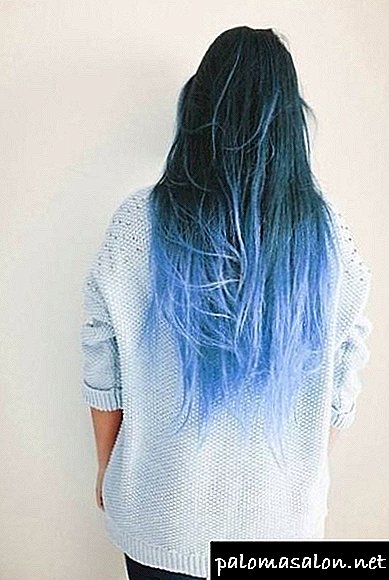
Very romantic image
Attention! Despite the limitless palette, professional stylists recommend choosing natural colors and shades (light brown, honey, wheat, chocolate, etc.). Firstly, it is easier to choose a successful “color pair”, and, secondly, natural beauty is always better than “colorful fireworks” on the head.
- If you contact an experienced hair stylist, then 100% will get an excellent result! After all, he knows how to professionally dye the ombre hair, and in addition to the discoloration of the tips, he will certainly put similar accents on the crown and near the face. These accent strands emphasize your individual characteristics - eye color, skin tone, cheekbones shape.
- If the ends become dry and bitten after painting, they can be cut off without problems. As you know, the roots are much more difficult to treat.
- With the illiterate performance of such shatush on the hair can look sloppy, tasteless - as if the roots have grown and need urgent painting.
- Gradient transition is not always combined with bangs, as it turns out defective game of color.
- If the native color is very dark, then the discoloration of the ends may not work out the first time (be prepared for a nondescript rusty shade).
- Bleaching the tips of “sick” strands can make their structure and appearance even worse. Therefore, it is better to pre-treat hair.
Video: Dark hair shatush version
A few short tips:
- The easiest way to do shatush for long dark hair. If your hair reaches the waist, try to leave 5–6 cm of hair in the root part free from dye. So it will be easier for you to act with a brush, it will be possible to control the whole process even during the coloring of the occipital strands, and the stretching of the color will be as natural as possible.
- Do not use home coloring if your hair barely reaches the shoulders. Without the help of a professional, you can hardly create something intelligible on them. And at a length of less than 5 cm technology simply does not apply.
- Very dark curls require careful selection of a brightener. Asian-style brunettes with thick, hard hair should look for bottles with a 12% mark, light brown-haired and dark blond - no more than 3%.
- Tanned fashionistas will face shades of gold and copper. Fair-haired women with pale skin should prefer cold ash and pearl tones.
- Those who are inconvenient to carry out the coloring "in the air", you can use foil, food film or sheets of white paper to lay colored strands.
- Bright blonde shatush not needed. Your hair, like no one else, will go Californian highlighting.
If your goal is to disguise gray hair, it would be nice to have an extra pair of hands and eyes nearby. Invite a girlfriend to the “coloring session” who will help you with the pile and apply the paint.
Precautionary measures
- Lightening is lightening. It is strictly contraindicated for damaged hair, and the treatment of split ends with dyes will literally turn them into straw in just two or three procedures, which they will only have to cut. Do not plan on shatush staining if your hair needs treatment.
- Two days before the procedure, stop washing your hair. To blot well, the strands will not have time, but they will be covered with sebum, which will soften the effect of the clarifier.
- Never save on paint or craftsman! It is not a pity for quality work and to pay properly - this is your hair!
If the coloring does not affect the roots, as is usually the case with French melirovaniem, the next visit to the hairdresser will take place no earlier than 2-3 months. However, young ladies who have darkened the basal area, will have to go and see the salon as hair regrowth.
Reviews with photos before and after
Looks natural and interesting. Highlighting is already tired, and it doesn’t look much ... I picked up the paint under my natural color (light brown), and the locks were lightened with paint (light blond), my hair took on a natural look, there was no trace of watermelon streaks!
Nadizykova
 The result is obvious!
The result is obvious!
Barber offered to try technology shatush and I agreed. And not sorry. Hair is less affected because not the whole volume is painted, and about 1/3 and a small oxidizer is taken. Very convenient for those who want to grow their color, staining as it compares regrown roots with the main length. Awesome effect! In general, I was absolutely satisfied.
Byaka
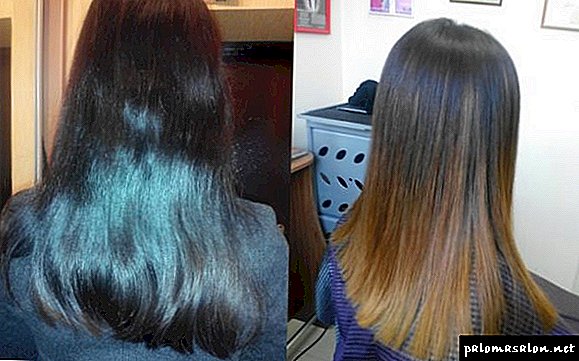 With such a head of hair go unnoticed will not work
With such a head of hair go unnoticed will not work
The result was very harmonious. The technique is quite complicated, I myself at home just would not have coped. The most difficult thing is not even to apply paint to oneself, having made a pile, but to calculate the necessary percentage of oxidizer, the time for aging, to choose a tint, while at the same time know what color it will turn outrather than hope for the occasion. Facial features are softer, more interesting hair. The transition from dark to light hair is very smooth. Looks nice on curls-waves.
Natasha Sonya
In general, shatush is another worthy representative of the “solar burnout” technique, which deserves the closest attention of girls who prefer to look bright, fashionable and at the same time remain faithful to their native hair color.
Method 5. Growing hair
If you have iron patience and don’t hurry anywhere, try growing your natural hair color. Of course, this method works only on blond hair, once painted in a dark shade. And it is also the longest (takes a couple of years), but also the safest.
Tip! To speed up the process, regularly use masks or tinctures from simple home remedies (red pepper, black bread, sour cream, natural honey, etc.). They not only stimulate hair growth, but also significantly improve their condition. It will not be superfluous to drink a course of special vitamins and once a month to cut the colored ends.
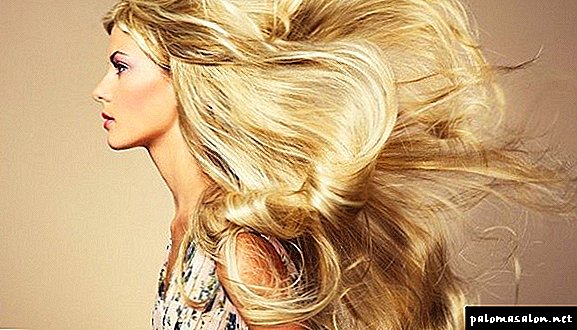
Features of dyeing hair in bright colors
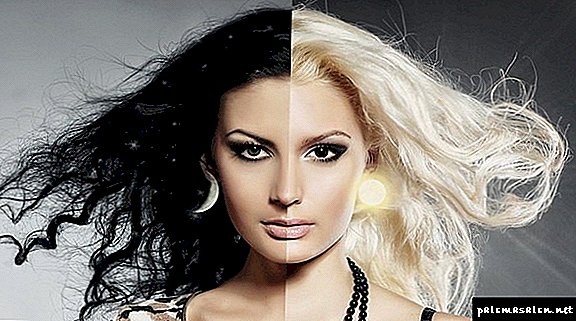
Blonde beauties have always attracted attention. Their hair usually shines in the sun, making its owner more feminine and younger. And even if you lighten the hair by only 2-3 tones, the effect of refreshing will already be noticeable. But if you do it wrong, then the hair is easy to ruin, and the color can turn out to be expressionless.
Ombre types
Here is a brief introductory overview of the current Ombre variations:
- Classics of the genre. Hair coloring in two similar tones with a very smooth, mild, most natural transition. And since this is a classic gradient highlighting, the colors are selected close to natural.
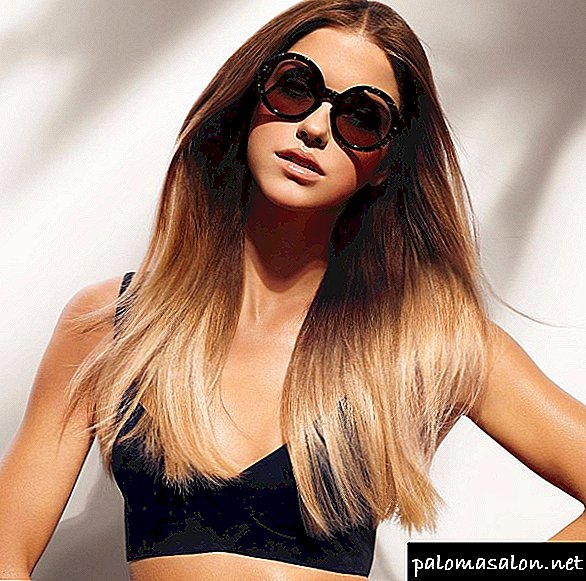
Classic shatush or, as it is also called, “sun kiss”
- Reverse ombre. In principle, everything is the same here. But the sequence of colors is different - the roots are light, and the ends are darker.
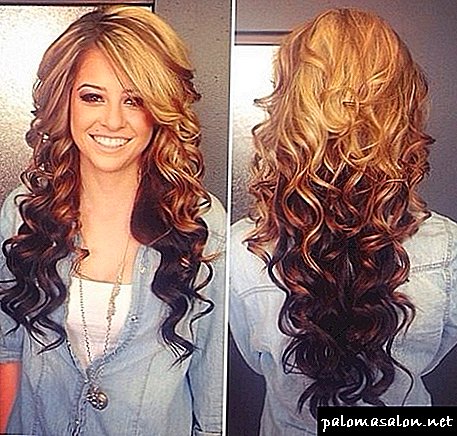
Reverse effect on chic wavy curls
- Transverse. This technique is quite complicated and requires certain skills, so do it yourself. Its essence lies in a very, very soft transition from light to more saturated.

To achieve this effect, highlighting is done on the selected length of the strands and then shaded.
- Pony tail or horse tail. In the summer days, when the sun is mercilessly baking, girls often collect their hair in ponytails. So, under the influence of the sun's rays, a uniform burnout is obtained along the hairline in the gum line. Coloring Pony tail is characterized by the same effect.
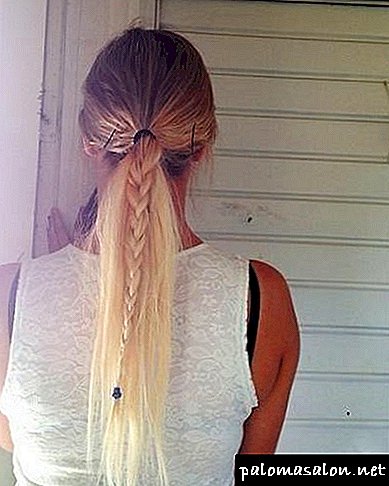
- Color Ombre. This is where you can "roam" and give vent to fantasy! Your choice of any, even the most extraordinary colors. In this case, you can use several colors and their shades at once. It is necessary to notice that the blue and red ombre on the hair looks quite nice.
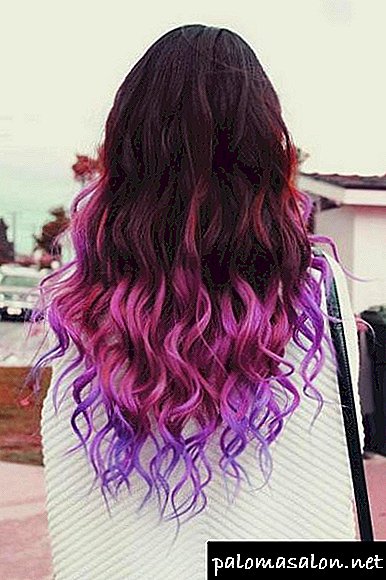
Fantastic play of colors on wavy strands
Good to know! The trend of the current season - lilac, blue, purple and pink tones in combination with natural black or brown hair color.
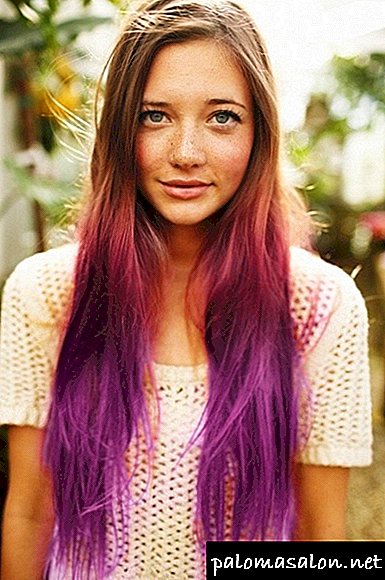
When natural beauty meets artificial ...
- Sharp. In this case, the instruction prescribes to make the transition as clearly as possible, richer, more noticeable. The choice of "color pair" is not limited.
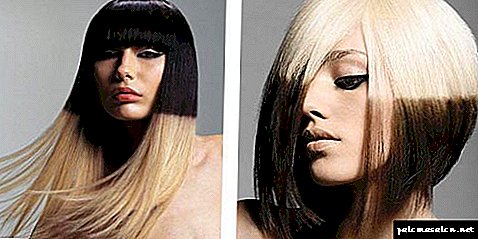
Elegant, slightly cheeky coloring with a sharp border
Classic ombre at home
So, now we will learn how to dye ombre hair using classical technology. At once, we say that doing it yourself is not so difficult, the main thing is responsible approach and attentiveness.

Visual walkthrough
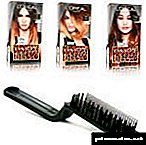
Preference Wild Ombres L’Oreal Paris hair dye with an ombre effect and a convenient brush for applying it
Gentle, strict or outrageous - ombre in any of its form can decorate your hair. It is only necessary to find a good master who will make the desired image a reality.
And in the case of the classic technique, you can do it yourself, using the instructions above or watching the video in this article.
Lightening problems
Dyeing hair in bright colors is always a stress for them. In order to lighten the hair, it is necessary to partially or completely neutralize the natural coloring pigment inside the hair shaft. And for this it is necessary, by physical or chemical means, to loosen the upper keratin layer, which protects the hair from moisture loss and the harmful effects of the environment.
As a result, the hair loses shine and strength. And the higher the degree of discoloration, the greater the damage. If for one coloring try to turn from a brunette to a blonde, then the result is likely to be deplorable. On the head you will get lifeless tow, which is impossible to properly lay and even comb, without pulling out a decent tuft of hair.
But this is not the only problem of clarification. Hair of warm tones: brown, wheat, red, often get after this procedure pronounced yellow tint, to get rid of that at home is almost impossible. It can be corrected with the help of tint balms or masked using persistent colors of golden tones.
Staining options
But is it still impossible to dye your hair a bright color without damaging it? Yes, there is still no perfect bleaching method. It is necessary to choose only between serious and weak damages.
But the more gently the composition operates, the less tones it will be possible to “wash off” from the head of hair with its help.
Bleaching compositions
The maximum effect of clarification is given by decolorizing structures. They also have to be used before using resistant paints that are more than 2-3 tones lighter than the original color. In general, when going from dark to light on previously dyed hair, experts recommend doing a wash. Otherwise it will not be possible to achieve the purity of a new tone.
In specialized stores today you can buy:
- Lightening powder. Recommended for professional use. Usually it contains a blue or purple pigment, which makes it possible to dye hair in light shades without yellowness. Its main advantage is high efficiency. It allows you to lighten the hair even by 6-8 tones. But doing it right away is not recommended. Failure to observe the correct proportions when diluting the powder or incorrectly setting the time of its exposure (and professionals select it individually!) Leads to a strong drying of the hair.
- Brightening gel. Modern high-tech novelty, with which natural hair of dark blonde and lighter shades can be lightened by 1-2 tones with almost no harm to them. The gel does not contain ammonia, and discolors the hair under the influence of hydrogen peroxide. It helps to speed up the heating (a hair dryer or under sunlight). The gel is not effective on colored hair, since such clarification is a physical process and cannot influence the chemical pigments injected.
- Wash. The most harmless of all clarifying agents. It contains the minimum concentration of the oxidizing agent, due to which it does not loosen the keratin layer too much. The flakes open up just enough so that it becomes possible to wash the previously introduced color pigment. On natural hair, this tool almost does not work. But it is very convenient in cases where after dyeing the shade turned out too dark or does not meet your expectations at all. Wrong color should be washed off, and not painted over by others - advised by experienced hairdressers.
It is advisable to choose a bleaching agent based on the structure and condition of the hair. If the hair is thin or heavily damaged by perm or staining, then the use of a brightening powder should be abandoned.
Ammonia paint
If you want to make the original shade lighter by 2-3 tones, then ammonia-resistant paints can be an excellent alternative. It is thanks to ammonia that the keratin layer is actively loosened, and the pigment is washed out.
You can gradually change the color to lighter even without using a wash. To do this, with each subsequent dyeing you need to buy paint one tone lighter than the previous one. Of course, such a transformation will take up to several months. But the transition will be smooth, without a sharp border at the roots and a strong damage to the hair.
To repaint from dark to light color, you will quickly have to use a wash or a bleaching powder. They will remove the pigment previously injected, and then new paint can be applied.
But such a procedure, especially performed on the same day, is the strongest stress for a head of hair, and then it requires careful care and long-term recovery.
Tint balms
The principle of their action is based on the creation around each hair of the thinnest film, in which there is a color pigment. It does not loosen, but, on the contrary, smoothes hair.
Therefore, the resulting color is quickly washed out, and its shade directly depends on the original hair color.
So brunettes can add a reddish or brown glow to their hair, and owners of brown hair can enhance the golden reflections on them.
For painting dark hair in light colors, tint balms are completely useless. All that they can do is slightly adjust the shade obtained with stronger means.
But they are simply indispensable for a cold-colored blond hair. Corrective "silver" balms quickly neutralize the unpleasant yellowness, which is manifested under the influence of poor quality water, smoking and ultraviolet radiation.
Modern technology
Modern techniques of non-uniform hair coloring, created on the basis of classical highlighting, are considered a gentle way of lightening: balayaz, ombre, shatush and others. They allow you to visibly lighten medium and long hair, damaging only individual strands.
These techniques have many advantages, since they all:
- visually increase the amount of hair,
- do not require frequent correction
- allow you to save intact roots
- perfectly mask insignificant gray hair,
- refresh your face and rejuvenate the image
- look stylish and modern
- allow you to experiment with additional toning.
An experienced master will always select for you individually the best painting technique and suitable shades. But such work is not cheap and this is perhaps the only minus of modern complex painting techniques.
By the time the procedure can take up to several hours if the hair is thick and three or more shades are used in the work.
For short and very curly hair, this alternative is hardly suitable. To make a non-uniform coloring look beautiful, the transitions between tones should be smooth. On a short haircut for this lack of length. And cool curls strongly intertwined, creating a color cacophony on the head. In these cases, it is better to choose a uniform color in beautiful light shades.
Folk Alternative
It is possible to dye hair in a lighter tone at home without severe damage to the structure of the hair with the help of folk methods. Naturally, they are not a full-fledged alternative to salon painting, but when used correctly they give very good results.
Here are some simple time-tested recipes:
- Lemon juice. Able to significantly accelerate the burning of hair in the sun. In winter, you can replace the natural heat with a regular hair dryer. Apply freshly squeezed and squeezed lemon juice diluted in half with water onto cleanly washed moist hair. Sit for an hour in the sun with your head uncovered (if not too hot!) Or heat the hair for 15 minutes at an average temperature. Repeat the procedure can be 1-2 times a week, the effect becomes noticeable after about a month.
- Chamomile decoction. A beautiful and completely harmless way to make blonde hair even lighter. A tablespoon of dried flowers pour a glass of boiled water, insist a couple of hours in a thermos or boil for 20 minutes in a water bath, drain. Dilute the resulting broth in half a liter of water and rinse hair after each wash. Lightening becomes noticeable after 8-10 applications. But the effect is short. If you stop using chamomile, the original color is returned.
- Kefir mask. In it, the active ingredient is lactic acid. It slightly neutralizes the natural pigment, penetrating deep into the hair shaft without destroying the keratin layer. At the same time, kefir mask moisturizes and nourishes the skin, and if you add honey and cinnamon, it activates the blood circulation and contributes to the activity of hair follicles. Kefir is applied first to the roots (you can gently massage the mask), and then distributed over the entire length. Cover the hair with cellophane, insulate and hold for 1-2 hours. Rinse with lukewarm water without shampoo.
There are other safe ways of home brightening, but they are suitable only for natural hair. Dyed hair can not make it lighter. Only stronger chemistry can withstand modern chemistry.
Home care
Since any dyeing in light shades somehow damages the hair, after it special attention should be paid to their restoration. To the hair hit minimally and quickly came back to normal, you should listen to the advice of professionals:
- apply lightening compounds and ammonia dyes only on unwashed hair,
- if the hair is badly damaged - it must be treated before lightening,
- Do not discolor hair more than 3-4 shades in one session,
- after dyeing with henna or basma, it is possible to lighten hair with ammonia formulations not earlier than in a month,
- frequent use of tonic dries hair - 3-4 times a month is enough,
- after lightening brown hair there is always a redhead on them, so for them it is necessary to choose warm light shades,
- the use of brightening compositions red hair can make a bright yellow, and this must be considered when choosing a shade,
- the thinner the hair, the more delicate light paint should be,
- with a large number of gray hair is to choose only natural shades that are easy to adjust tonic,
- at least two weeks after the light painting, it is desirable to abandon the ironing and curling, and the hair dryer to use at minimum temperatures,
- at least once a week it is necessary to pamper your hair with regenerating masks, and use air conditioning after each wash,
And of course, we must not forget about thermal protection and spray with UV filters. They neutralize the adverse effects of the environment and allow longer to keep the hair alive, shiny and supple.
How to dye your hair in dark colors without darkening at the ends? The secret of even color

What is difficult to dye your hair dark? Smeared, washed, and all things! Whether it's discoloration, toning and other scuffling with a blond, but everything is not so simple. Of course, if you paint in black, problems with getting into the color usually does not arise, and if you need to regularly dye your hair in color at the level of 5.0 or 6.0? Yes, so that the ends are not obscured and gray hair stained? Already more difficult?
In this article, we will discuss hair coloring in dark colors, reveal the secret of coloring without darkening the hair at the ends, and also answer the question: can the percentage of oxidizer be lowered by diluting it with water?
Why are women willing to pay a lot of money to hairdressers to decide to dye their hair at home? I can answer for myself, because the hairdresser who takes this money cannot do the elementary - to dye your hair dark, not darkening the ends, at the sight of gray hair grabs a bottle of 6% oxidizer and does not hesitate to offer color remover because the ends of the hair are “darkened” ".
They are not blacked out, dear, it is you, with your illiterate coloring, they are darkened!
To understand how to dye hair in dark tones without darkening, first let's see why the ends of the hair can be darkened.
To do this, we need to say, than primary staining differs from re. So, the primary dyeing of natural hair is as follows: the dye is applied first on the canvas of hair and only then on the roots.
If the dye is applied according to the standard scheme - first the roots, and then the length, then the color will be uneven: at the roots it is lighter and brighter, and to the canvas it is darker.
This occurs because the reaction under the influence of the natural heat of the skin of the head proceeds faster and more intensely.
Repeated staining is done with the exact opposite, first the roots are stained and only then the length. Manufacturers recommend averaged exposure time when re-staining.
For example, the instructions of L'Oreal Professionnel Majirel dye are clearly spelled out: if the color is dull, you should apply the dye 20 minutes before the end of the exposure time, if saturated, then 5 minutes before the end of the exposure time. Why such a big run - as much as 15 minutes?
The producers of L'Oreal Professionnel Majirel use the terms “saturated / dull”, but it would be more accurate to call it the saturation of pigment.
Dyed dark hair is extremely rarely washed away for six weeks so that the pigment is washed out of the hair completely.
This is possible if you dye your previously bleached hair without pre-pigmentation in a dark color, but this is not a typical case! Most often, the hair on the web retains the pigment and during subsequent coloring accumulates it, which is why it is darkened.
And now let's remember how in most cases hair is dyed in dark colors (5.0 and all shades of the fifth level, 6.
0 and all shades of the sixth level) in hairdressing salons of different levels: put paint on the roots (5-10 minutes depending on the length of hair), then immediately paint on the canvas (5-10 minutes depending on the length) and put the client to read the magazine for the remaining time. On average, it turns out that the paint affects the hair longer than 20 minutes.
We have already discussed the principle of the oxidizer. Briefly - the oxidizer, interacting with ammonia dyes, lifts the hair scales. The higher the percentage of oxidant, the more aggressive this process.
L'Oreal Professionnel Majirel works with a 6% oxidizer. It is enough to dye your hair 2 times with 5.0.
with 6% oxidizer throughout the web to get a strong top three at the ends, five minutes to black.
How to avoid it?
A typical example: re-dyeing, the base color of natural hair is 6.0, gray hair is 45% focal (marginal hair growth + temples), the desired color is 5.0.
We'll paint L'Oreal Professionnel Majirel 5.0 +, and here I’m breaking all the rules, using an oxidizer of 2.7%, not recommended by the manufacturer, 6%, L'Oreal Professionnel Dia Activateur 2.7%, intended for L'Oreal Professionnel tinting paint Dia Richesse.
There is a logical question "how so?".
The manufacturer clearly explained in the instructions that the paint works with 6% and 9% oxidizer, then it was necessary to take the native dye, that same Dia Richesse, not Majirel, but the situations are different! There is Majirel dye, a scalp that does not tolerate anything above 3%, and there is L'Oreal Professionnel Dia Richesse 2.7%. However, there is also a 6% oxidizer, which, theoretically, could be diluted with water to ... stop! But this just can not be done in any case!
When we replace one oxidizer with another, or even use an oxidizing agent of the wrong company, as paint is, of course, not very good, but it is viable, but when water comes into play, shampoo, balm and other liquids are hands to tear off came up with these recipes!
Hydrogen peroxide is a highly unstable compound, manufacturers of professional cosmetics are seeking to stabilize it by adding special components - stabilizers. There are only three ways to change the percentage of stabilized peroxide:
- increase pressure
- heat strongly
if you add water to the stabilized peroxide (no matter what temperature), it will separate into water and ... flakes of peroxide, i.e.
the percentage of the composition does not go down! What will happen to the hair in this case? Part of the dye that entered into the reaction with water will work, as the composition for repigmentation, and part - as a dye.
Obviously, the quality of hair, color and color fastness in this case is unnecessary to discuss.
The third way to lower the percentage of oxidizer (peroxide) is to add a smaller percentage to the oxidizer. There are no more ways!
A few examples:
- to get 60 ml of oxidant 4.5%, you need to mix 30 ml of 3% and 30 ml of 6% of oxidant.
- Do you have 12% and 3% oxidant? Do you need 6%? mix one part 12% and 2 parts of 3% oxidizer.
So back to staining in dark tones.
We mix paint with an oxidizer according to the instruction 1: 2.
Apply to the roots, going abroad natural and dyed hair by about 4-5 cm.
Keep 20 minutes.
15 minutes before the end of the exposure time (only 35 minutes) we put on gloves and “stir the paint”, distributing it slightly beyond the borders of dyed and not colored hair.
(I got this “crown”).
We stand the remaining time.
Those. We do not distribute paint over all length at all! It is important to understand that we are talking about dark colors: 5.0, 6.0 and others in this range. If you dye your hair in red tones at level 6, this method is not suitable for you!
After the end of the exposure time, we go to the bath and, slightly wetting the hair with warm water, distribute the paint over the entire length of the hair. You can gently massage the hair over the entire length, stretching the dye for 2-3 minutes, after which everything is washed off and my head with shampoo. Such emulsification with water is quite enough to refresh the dark color and avoid darkening!
I hope this article will be useful to those who dyes their own hair.If you have any questions, write them in the comments, and we will try to answer you as soon as possible.
It was not possible to lighten the hair with paint, how to even out the color? Tips and photo examples
How to wash off the black color of dyed hair? Wash Tips and Recipes
Change of image: is it worth to dye your hair black? A good example of black wash

